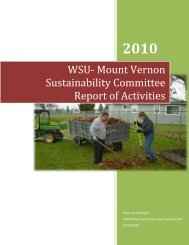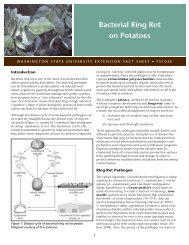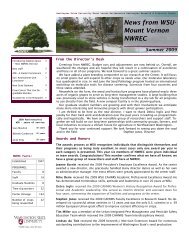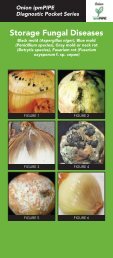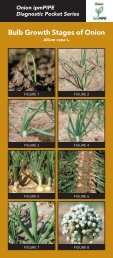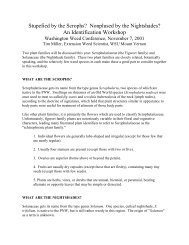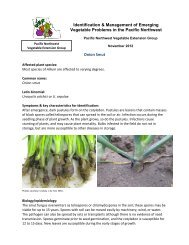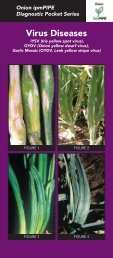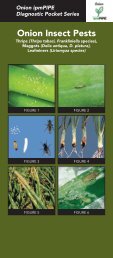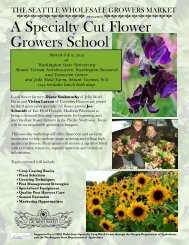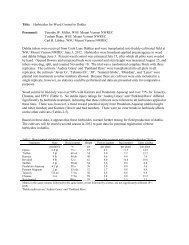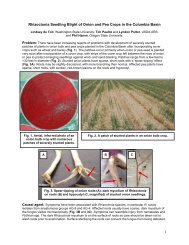Thielaviopsis Root Rot of Pea
Thielaviopsis Root Rot of Pea
Thielaviopsis Root Rot of Pea
You also want an ePaper? Increase the reach of your titles
YUMPU automatically turns print PDFs into web optimized ePapers that Google loves.
Identification & Management <strong>of</strong> EmergingVegetable Problems in the Pacific NorthwestPacific NorthwestVegetable Extension GroupPacific Northwest Vegetable Extension GroupNovember 2012<strong>Thielaviopsis</strong> <strong>Root</strong> <strong>Rot</strong> <strong>of</strong> <strong>Pea</strong>Affected plant species:<strong>Pea</strong> and many other plant species (e.g., alfalfa, bean, beet, carrot, onion, and sweet potato).Common name <strong>of</strong> the causal organism:<strong>Thielaviopsis</strong> root rot or black root rotLatin binomial:<strong>Thielaviopsis</strong> basicolaSymptoms & key characteristics for identification:Symptoms appear as dark black lesions on the roots and below ground stems (Fig. 1A). Thelesions can be similar to those associated with Fusarium root rot on pea. A thin section <strong>of</strong> theinfected tissue on a microscope slide will reveal the presence <strong>of</strong> the dark-colored survivalspores called chlamydospores, and potentially also the clear endoconidia (Fig. 1B). Severelyinfected plants may be stunted and leaf tissue can begin to turn yellow, starting at the base <strong>of</strong>the plant and moving up the plant.ABFig. 1. A) <strong>Thielaviopsis</strong> root rot symptoms (photo courtesy <strong>of</strong> Lyndon Porter). B) <strong>Thielaviopsis</strong> basicola survivalspores called chlamydospores (black arrows) as well as endoconidia (red arrows) commonly found in infected peatissues (photo courtesy <strong>of</strong> Avi Alcala).
Biology/epidemiology:High moisture and high soil temperatures (82 o F and greater) promote development <strong>of</strong> thisdisease in pea; however, severe losses can occur at lower temperatures. The pathogen canspread throughout the field via movement <strong>of</strong> infested soil, infected plant tissue, colonizedorganic debris, and irrigation water.Management:Avoid short pea rotations in fields that have high levels <strong>of</strong> the pathogen is extremely importantsince the spores <strong>of</strong> this pathogen survive in the soil for several years. T. basicola has a wide hostrange (can infect >130 species <strong>of</strong> plants) including alfalfa, beans, beets, carrot, onion, and sweetpotato which are sometimes grown in rotation with pea crops in the Pacific Northwest.Appropriate crop rotations will help avoid build-up <strong>of</strong> the pathogen in soil. Fields with a history<strong>of</strong> T. basicola infestation need to be rotated out <strong>of</strong> peas and other hosts to reduce the number<strong>of</strong> survival spores present in the soil and capable <strong>of</strong> infecting subsequent susceptible hosts.Disease symptoms are less severe at a soil pH <strong>of</strong> 5.6 or less. Soil fumigants such as chloropicrin,methyl isothiocyanate, and dazomet, and sterol inhibitor fungicides such as triazoles(thiabendazole) applied as soil treatments are reported to be effective against T. basicola.These compounds applied to any crop with a history <strong>of</strong> T. basicola may provide some efficacyagainst the build-up <strong>of</strong> this pathogen in a cropping system where peas are in the rotation.Captan applied as a soil treatment has also been reported to help manage this pathogen. Some<strong>of</strong> these management strategies may be cost prohibitive for application on peas but may bejustified on crops rotated with pea, which can limit the impact <strong>of</strong> this disease. Crop rotationwith a non-host, such as cereal, is important to limit pathogen build-up in the soil. Theherbicide chloramben can increase severity <strong>of</strong> T. basicola root rot. Benomyl applied at 1.7 kga.i./ha and thiophanate-methyl at 3.2 kg a.i./ha applied to soil suppressed T. basicola inpeanuts, so similar chemistries may be effective as soil treatments in peas. Always follow labelinstructions.Selected references:Abawi, G.S. and Hanson, L.E. 2005. Black root rot. In: Compendium <strong>of</strong> Bean Diseases, 2 ndEdition. Editors H.W. Schwartz, J.R. Steadman, R. Hall, and R.L. Forster. APS Press, St. Paul,MN. pp. 12-13.Harman, G.E. and Dillard, H.R. 2001. <strong>Thielaviopsis</strong> root rot. Pp. 17-18, in: Compedium <strong>of</strong> <strong>Pea</strong>Diseases and Pests, 2 nd Edition. Editors J.M. Kraft and F.L. Pfleger. APS Press, St. Paul, MN.PNW VEG website at http://mtvernon.wsu.edu/path_team/vegpath_team.htm and PhotoGallery at http://mtvernon.wsu.edu/path_team/diseasegallery.htm



